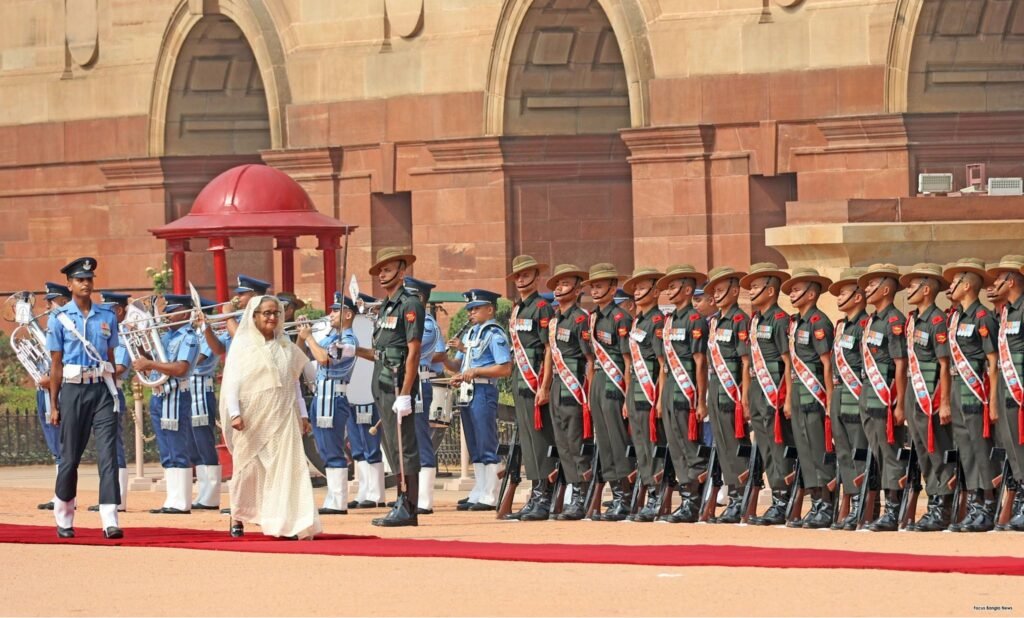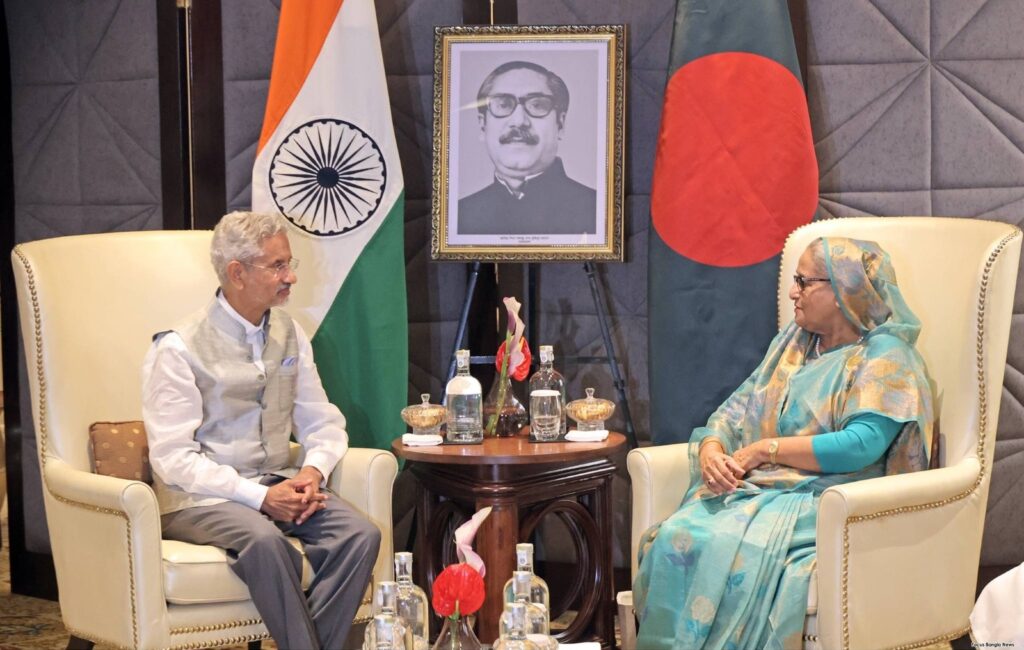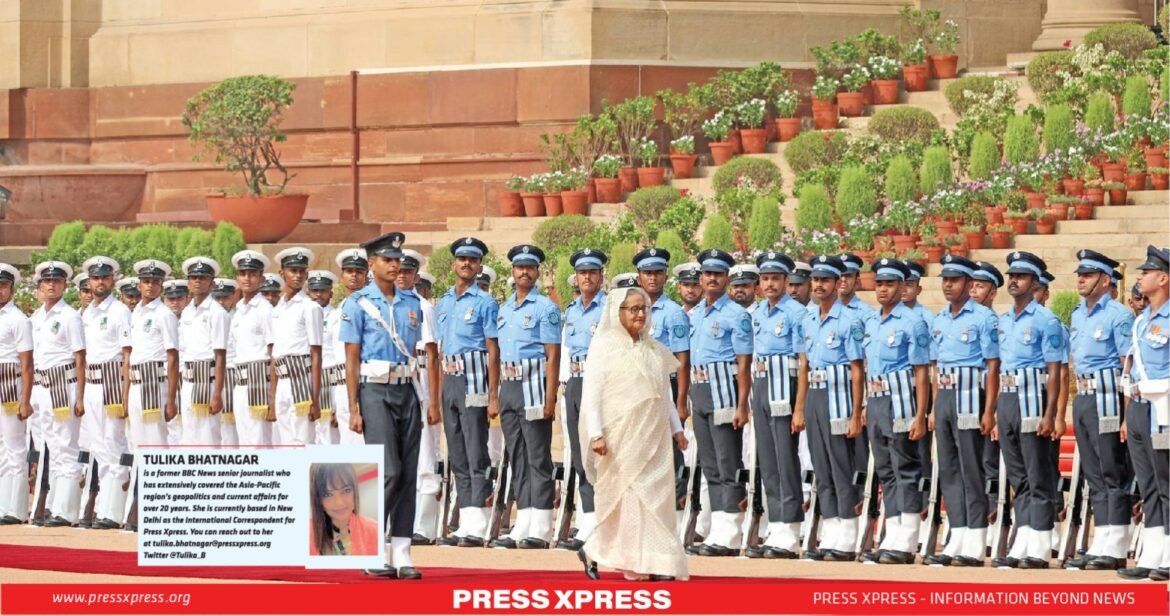Bangladesh Prime Minister Sheikh Hasina arrived in India on 21 June – marking her second visit in less than two weeks.
No prime minister of Bangladesh has visited India twice in such a short time in the recent past. On 9 June, Hasina had travelled to New Delhi to attend the oath-taking ceremony of Indian Prime Minister Narendra Modi.
Her current 2-day India visit has been kept brief as Hasina needs to be in Dhaka on 23 June to attend the 75th founding anniversary programme of her ruling Awami League party.
Yuo can also read: How Can Bangladesh Leverage the Global Social Justice Coalition?
However, this particular visit has gained special significance, coming shortly ahead of the 9-12 July trip to Beijing – where it is likely that China and Bangladesh would sign a free trade agreement (FTA) to enhance bilateral ties.
China’s growing clout in Bangladesh has kept India on tenterhooks even as PM Hasina has been credited with skilfully balancing the sensitive power dynamics, while at the same time, keeping her own country’s interests at the top.

What’s on the agenda?
On Saturday morning, a ceremonial reception at Rashtrapati Bhavan welcomed Sheikh Hasina with both national anthems played.
She also inspected the guard of honour and later, paid tribute to Father of Nation Mahatma Gandhi at Raj Ghat.
Modi and Hasina in their meeting later today, are expected to issue a “vision statement” that will detail the future direction of bilateral relations.
There is likely to be a significant announcement regarding the Teesta water conservation, management, and development – an issue of contention between the two countries for many years.

India is also likely to invest in several projects centring around the Teesta river, a highly crucial development given that China has been increasingly getting interested in investing in similar projects.
“It’s a very important visit for us, the first state visit from the neighbouring countries. Both sides have a lot of expectation because the relationship is so special and so friendly,” said Randhir Jaiswal, spokesperson at the Indian Ministry of External Affairs at a recent media briefing in Delhi.
Modi and Hasina will also witness the signing ceremony of several MoUs and agreements. Additionally, discussions on a potential trade pact are expected. Over the past decade, numerous cross-border initiatives have been launched as part of a robust regional partnership plan.
Local reports say the signing of agreements include a new outline to speed up the implementation of India’s line of credit, and ensuring supply of essentials to Bangladesh in any circumstance.
Various other issues including economic operation, trade, connectivity, fuel, border killings, defence and new technology could also be discussed at the bilateral meeting.
Among other significant topics, the two leaders are also expected to touch upon the issue of security, the situation in Myanmar, existing Rohingya crisis, as well as security situation in Chittagong hill tracts in Bangladesh and India’s northeastern state of Manipur.
Delhi, Dhaka, Beijing triangle

The issue of Beijing has been coming up in various talks on the Delhi-Dhaka relationship in recent years.
India has witnessed growing tension along its borders with China, while China has added a new dimension to its relations with India’s neighbouring countries.
So, the crucial point of Hasina’s current visit is also to maintain balance, before she goes to Beijing after wrapping up her Delhi trip.
In Beijing, she will hold a bilateral meeting with Chinese premier Li Qiang and meet Chinese president Xi Jinping.
According to Chinese Ambassador to Bangladesh Yao Wen, Hasina’s visit to Beijing would be a “game-changer”.
“There will be a new chapter (opening) in terms of China-Bangladesh relations. So let’s wait and see,” he told reporters in Dhaka recently, adding that first and foremost, a China-Bangladesh FTA (free trade agreement) was imperative and an “inevitable choice” for Bangladesh to achieve its Vision 2041.
Currently, the only trade and investment agreement between the two countries is the 1996 Agreement on the “Encouragement and Reciprocal Protection of Investments”, which does not align with the increasingly close relations and exchanges between the two countries, the ambassador said.
A China-Bangladesh FTA would cover areas such as trade in goods, trade in services, investment, e-commerce and high-tech industry cooperation, providing a basic framework and solid guarantee for future bilateral economic and trade cooperation.
In terms of trade, China has maintained its position as Bangladesh’s largest trading partner for 13 consecutive years, with bilateral goods trade reaching $24 billion in 2023.
Even in terms of investment, China’s FDI (Foreign Direct Investment) stock in Bangladesh reached $3.2 billion by 2023, making China the second-largest investing country in Bangladesh. Chinese firms have also constructed seven railways, 12 roads, 21 bridges, and 31 power plants in Bangladesh.
Beijing has spent $4 billion on its Belt and Road Initiative projects in Bangladesh, with plans for a total of over $50 billion in the coming years.
However, India has often cautioned Bangladesh of China’s moves in other neighbouring countries such as Pakistan and Sri Lanka, where initial investment temptations have led to severe economic crises.
Delhi is also pointing out Dhaka’s trade deficit with Beijing, which is nearly $21 billion, and mounting.
While Beijing is exporting to Dhaka, the same isn’t true for Dhaka – China’s markets are yet to open up for Bangladeshi goods – textiles, jute and other products.
While Dhaka could be looking for a long-term loan from Beijing in view of its falling forex reserves, India cautions that Beijing would likely do it at high interest rates and other conditions – as it has done with other neighbouring countries.
Yet another concern for India is China’s funding and building of a submarine base in Bangladesh, not far from Dhaka.
Therefore, Delhi is keenly watching Dhaka’s balancing act with Beijing, raising caution that China would keep Bangladesh under its new radar with new and stringent demands for compliance. How Hasina navigates this triangle keeping Dhaka’s interests close to her heart, remains to be seen, even as the premier has proven herself time and again on managing the deeper geopolitical undercurrents.


